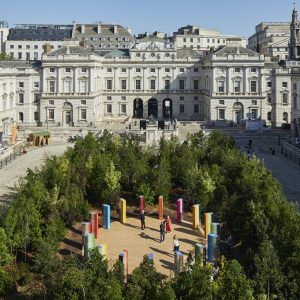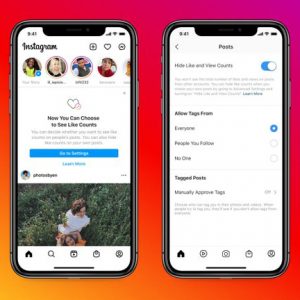Link About It: This Week’s Picks
Missions to Venus, cardboard mazes, mental health and more in our look around the web

Es Devlin’s “The Forest for Change” at London Design Biennale
 The 2021 London Design Biennale art director, renowned artist and stage designer, Es Devlin planted 400 trees in the otherwise empty courtyard at Somerset House for “The Forest for Change” installation. The neoclassical complex was built in accordance with Enlightenment ideals; “principles of simplicity, symmetry, mathematical precision and absolute functionality” that rebuffed the opulent designs of preceding baroque and rococo eras. In fact, no trees were allowed to be planted in Somerset House since its architect Sir William Chambers forbade it 250 years ago. Again rebuking past design principles, Devlin had 23 species of trees (all native to the region) planted in the cobblestone courtyard. Visitors are encouraged to wander through the forest, which houses colorful pillars in the middle, all of which display information about climate, health, inequality and other big issues. Read more at The Conversation.
The 2021 London Design Biennale art director, renowned artist and stage designer, Es Devlin planted 400 trees in the otherwise empty courtyard at Somerset House for “The Forest for Change” installation. The neoclassical complex was built in accordance with Enlightenment ideals; “principles of simplicity, symmetry, mathematical precision and absolute functionality” that rebuffed the opulent designs of preceding baroque and rococo eras. In fact, no trees were allowed to be planted in Somerset House since its architect Sir William Chambers forbade it 250 years ago. Again rebuking past design principles, Devlin had 23 species of trees (all native to the region) planted in the cobblestone courtyard. Visitors are encouraged to wander through the forest, which houses colorful pillars in the middle, all of which display information about climate, health, inequality and other big issues. Read more at The Conversation.
Image courtesy of Ed Reeve/The Conversation
Simon Fujiwara’s Cartoonish “Who the Bær” Exhibit at Fondazione Prada
 With the solo site-specific installation Who the Bær, on now through 27 September at Fondazione Prada, British-Japanese artist Simon Fujiwara utilizes a cartoon bear named Who to explore various identities, as well as news stories and cultural events from the last year. Fujiwara’s Who appears within drawing, sculpture, stop-motion animation and collage, all placed through a maze of cardboard walls that also form the shape of a bear. The entire adventure-like experience is told through Who’s life “in a ‘cartoonified’ media landscape,” according to the artist. Read more about the imaginative exhibition at Frieze.
With the solo site-specific installation Who the Bær, on now through 27 September at Fondazione Prada, British-Japanese artist Simon Fujiwara utilizes a cartoon bear named Who to explore various identities, as well as news stories and cultural events from the last year. Fujiwara’s Who appears within drawing, sculpture, stop-motion animation and collage, all placed through a maze of cardboard walls that also form the shape of a bear. The entire adventure-like experience is told through Who’s life “in a ‘cartoonified’ media landscape,” according to the artist. Read more about the imaginative exhibition at Frieze.
Image courtesy of Fondazione Prada
NASA Plans Two Missions to Venus
 As news, images and sound from many missions to Mars continue to appear, NASA has announced two missions to Venus for the first time in over three decades. With launches planned for 2028 to 2030, the space agency’s goals are in essence to “rediscover” the planet, which “scientists believe could have been the first habitable planet in the solar system.” The deep space endeavors will cost about $1 billion, and Tom Wagner—lead at NASA’s Discovery Program—says, “It is astounding how little we know about Venus, but the combined results of these missions will tell us about the planet from the clouds in its sky through the volcanoes on its surface all the way down to its very core. It will be as if we have rediscovered the planet.” Read more at The Guardian.
As news, images and sound from many missions to Mars continue to appear, NASA has announced two missions to Venus for the first time in over three decades. With launches planned for 2028 to 2030, the space agency’s goals are in essence to “rediscover” the planet, which “scientists believe could have been the first habitable planet in the solar system.” The deep space endeavors will cost about $1 billion, and Tom Wagner—lead at NASA’s Discovery Program—says, “It is astounding how little we know about Venus, but the combined results of these missions will tell us about the planet from the clouds in its sky through the volcanoes on its surface all the way down to its very core. It will be as if we have rediscovered the planet.” Read more at The Guardian.
Image courtesy of NASA/JPL
Instagram Allows Users to Hide “Likes” On Their Posts
 For some time, rumors swirled that Instagram would remove “like” counts from posts as experiments on the effect rolled out across the US and Canada. Now, the platform (as well as its parent, Facebook) have made it possible for users to hide the likes on their posts. This is due to what the team at Instagram is calling an attempt to “depressurize people’s experience,” as the double-tap oftentimes equates to validation that’s tied to mental health. As Thom Waite writes for Dazed, “In 2020, a study published in Human Behavior and Emerging Technologies showed that sharing selfies on Instagram — and, importantly, receiving high numbers of likes and positive comments — is tied to living a happier life.” Instagram didn’t get rid of “likes” altogether, perhaps unsurprising when one considers the influencer industry and the fact that products are shoppable on the platform. Read more at Dazed Digital.
For some time, rumors swirled that Instagram would remove “like” counts from posts as experiments on the effect rolled out across the US and Canada. Now, the platform (as well as its parent, Facebook) have made it possible for users to hide the likes on their posts. This is due to what the team at Instagram is calling an attempt to “depressurize people’s experience,” as the double-tap oftentimes equates to validation that’s tied to mental health. As Thom Waite writes for Dazed, “In 2020, a study published in Human Behavior and Emerging Technologies showed that sharing selfies on Instagram — and, importantly, receiving high numbers of likes and positive comments — is tied to living a happier life.” Instagram didn’t get rid of “likes” altogether, perhaps unsurprising when one considers the influencer industry and the fact that products are shoppable on the platform. Read more at Dazed Digital.
Image courtesy of Instagram
Link About It is our filtered look at the web, shared daily in Link and on social media, and rounded up every Saturday morning. Hero image courtesy of Ed Reeve/The Conversation












